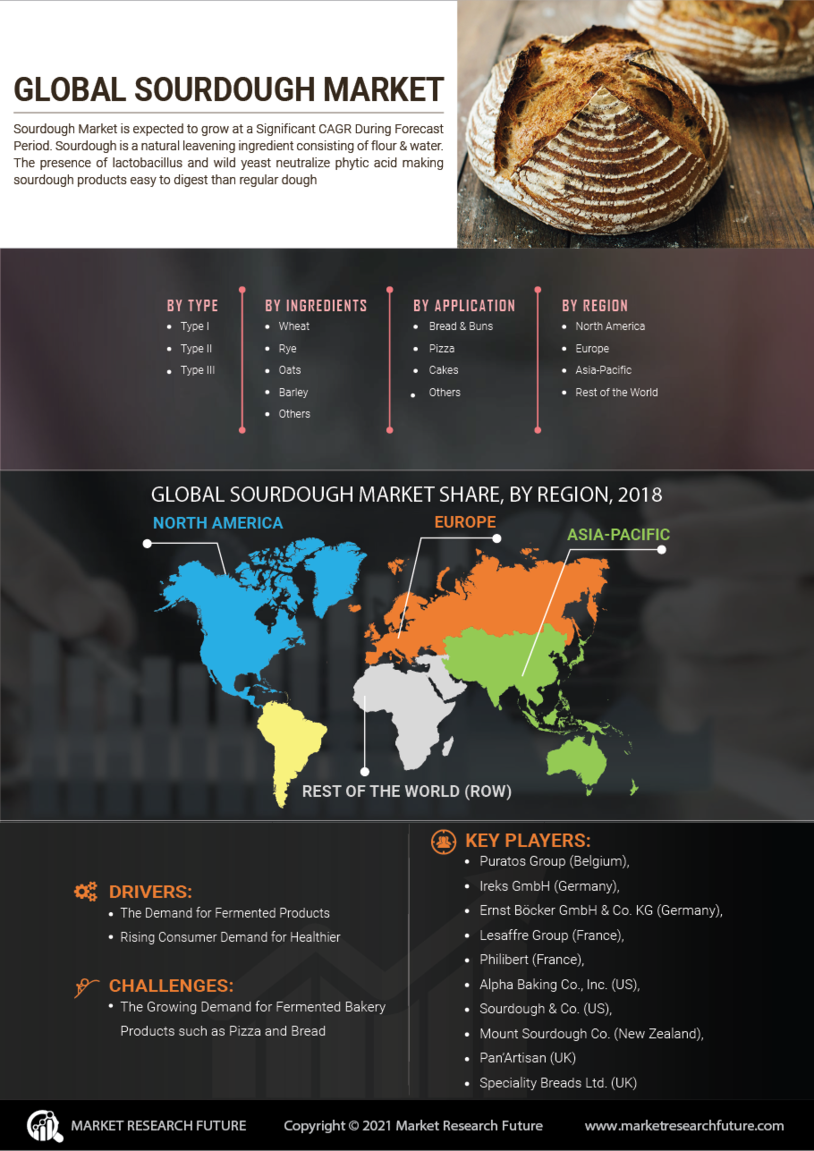Global Sourdough Market Overview
Sourdough Market Size was valued at USD 2,553.57 million in 2022. The Sourdough market industry is projected to grow from 2022 to USD 6,900.13 million by 2032, exhibiting a compound annual growth rate (CAGR) of 13.39% during the forecast period (2023 - 2032). Veganism is a way of life where individuals exclude the consumption of animal-based food and non-food products in every walk of life. In place of animal-derived products, people tend to prefer products that are made using plant-based sources and materials which help them to attain a positive impact on animal welfare and the environment. Further, it is estimated that there are around 16.5 million Americans who are either following vegan or vegetarian diets in equal percentage. In line with the increasing vegan population, the availability of plant-based food products in the food service industry with the launch of restaurants Plant Power Fast Food, Amy’s Drive Thru, Veggie Grill, and Monty’s Good Burger in the US which offers a variety of plant-based food products. In addition to new store launches, non-vegan restaurants such as Taco Bell, Fatburger, and others started offering products that cater to the needs of vegans.
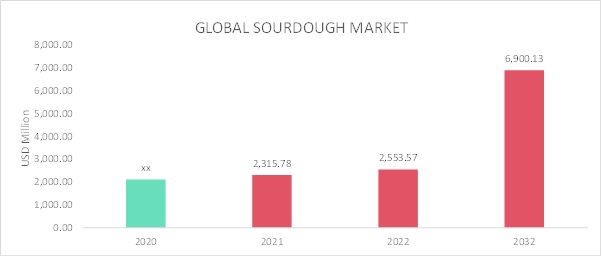
Source: Secondary Research, Primary Research, MRFR Database and Analyst Review
Sourdough Market Trends
- Increasing Number of Health-Conscious Consumers And Rising Popularity Of Sourdough
Health-conscious consumers have been on a constant rise over the years owing to the growing awareness of the importance of health and wellness. With the rise of chronic diseases such as obesity, diabetes, and heart disease, people are recognizing the need to take proactive steps toward maintaining their health. Another factor contributing to the trend is the availability of health information. With the internet and social media, people have access to a vast amount of information about nutrition, fitness, and wellness. This has led to a greater awareness of the impact of food and lifestyle choices on health. According to the Pew Research Center, a nonpartisan think tank survey among the population in the US has highlighted that around 72% of them believe that leading a healthy and long-life adoption of healthy eating is a key factor and according to a consumer behavior analysis among European countries by MRFR has witnessed that around 64% of consumers are focusing on the impact of food on health and wellness,
Sourdough bread has gained immense popularity in recent years due to its numerous health and nutrition benefits. The fermentation process involved in creating sourdough bread gives it a distinctive taste and texture and also provides several advantages over traditional bread. The low pH levels in the sourdough bread and the lengthier fermentation time are helping in better nutrient availability including carbohydrates and proteins. The lactic acid in sourdough plays a vital role in improving digestion. It helps break down the phytic acid in grains, which can interfere with nutrient absorption. This makes sourdough bread easier to digest and also improves gut health. Furthermore, scientific studies highlight that the acids released in the fermentation process help in slow digestion of starches thus preventing the blood glucose and insulin levels making it a suitable choice for diabetic individuals. Individuals who are engaged in weight loss are increasingly preferring sourdough bread to regular bread as they help in the production of short-chain fatty acids whose surge in levels results in a reduction of diet-induced obesity. However, sourdough bread inherently has higher levels of calories which might impact the overall calorie consumption.
The increasing popularity of sourdough is further demonstrated by the Craft Bakers Association’s data indicating that around 57% of the association members sold three sourdough products in April 2022 which further increased to 64% by December 2022. Further, around 10% of the members are planning to expand their sourdough products offering in the upcoming years. Similar is the trend among various countries across the world. Thus, the increasing number of health-conscious customers and the rising popularity of sourdough is expected to drive the growth of the Sourdough Market.
Sourdough Product Type Insights
The Sourdough Market segmentation, based on product type, includes type I, type II, and type III. The type III segment accounted for the largest market share of 47.00% in 2022 and is likely to register a CAGR of 10.73% during the projected period. Type III can be dried or lyophilized. It is preferable for use in an industrial bakery because it has a higher stability quality than fresh sourdough. The fermentation temperature used is above 30 °C and in a single time stage between 24–72 hours. Type III is a hybrid and combines type II by using a starter culture with type I for propagating the sourdough with back-slopping. Type III is common in artisan bakeries and industrial ones. Type III pertains to the extraction rate of the flour employed in crafting this sourdough, striking a unique balance between refined and whole-grain elements of the wheat kernel. This particular flour blend contributes to a distinctive flavor profile, offering a harmonious interplay of nuttiness and a subtle sweetness, making Type III sourdough a tantalizing experience for discerning taste buds. At the heart of this culinary creation is a well-nurtured sourdough starter, a lively synergy of wild yeast and lactic acid bacteria that serves as the engine of fermentation, imparting the characteristic tanginess and complexity to the bread. From a nutritional perspective, Type III sourdough stands out as a wholesome choice that caters to the evolving preferences of health-conscious consumers. The inclusion of alternative grains often brings unique nutritional attributes to the bread, such as increased fiber content, essential minerals, and a broader spectrum of vitamins. This aligns with the contemporary understanding of the importance of a diverse and nutrient-rich diet for overall well-being.
Figure 1: Sourdough Market, by Product Type, 2022 & 2032 (USD Million)
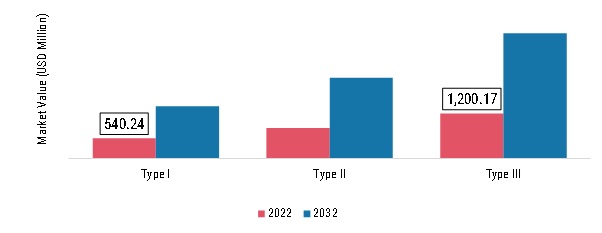
Source: Secondary Research, Primary Research, MRFR Database and Analyst Review
Sourdough Form Insights
The Sourdough Market segmentation, based on form, includes dry and liquid. The dry segment accounted for the largest market share of 60.24% in 2022. The dry sourdough comes in a dehydrated or powdered state, encapsulating the magic of wild yeast and lactic acid bacteria in a stable form. This innovation offers a practical solution for home bakers and professionals alike, eliminating the need for the continual maintenance of a sourdough starter. The dry form simplifies the sourdough-making process, providing a shelf-stable and user-friendly alternative while still preserving the characteristic tangy flavor and complex aroma associated with traditional sourdough. The versatility and ease of use make dry sourdough appealing. By removing the need for a living starter, bakers can bypass the time-consuming and sometimes finicky task of daily feedings and maintenance. This convenience opens the door to a wider audience, allowing even novice bakers to embark on the rewarding journey of sourdough baking without the initial hurdle of cultivating and sustaining a sourdough starter. The powdered form, typically made by dehydrating a mature sourdough starter, offers a reliable and consistent source of microbial cultures, ensuring a successful fermentation process with each use.
To activate dry sourdough bakers simply rehydrate the powder with water and mix it with flour to create a dough. This streamlined process saves time and effort while maintaining the integrity of the sourdough tradition. The resulting bread retains the characteristic tanginess, chewy texture, and open crumb structure associated with sourdough, providing a satisfying and authentic baking experience. The dry form also facilitates experimentation with various flours and hydration levels, giving bakers the flexibility to tailor their recipes to personal preferences.
Figure 1: Sourdough Market, by Form, 2022 & 2032 (USD Million)
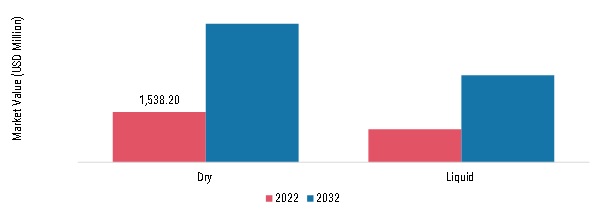
Source: Secondary Research, Primary Research, MRFR Database and Analyst Review
Sourdough Market Segment Insights:
Sourdough Source Insights
The Sourdough Market segmentation, based on source, includes wheat, rye, oats, and barley. The regular segment held the majority share in 2021 concerning the Sourdough Market revenue. Wheat, the quintessential cereal grain that has been a staple in human diets for millennia, stands as a venerable source for crafting the distinctive and beloved bread known as sourdough. The journey of wheat from the field to the fermentation vessels of sourdough enthusiasts is a fascinating exploration of agriculture, milling, and the art of bread making. Sourdough, at its core, is a symbiotic collaboration between wheat and a dynamic microbial community, resulting in a loaf that bears the unique flavors, textures, and nutritional benefits inherent in this versatile grain. Wheat varieties, such as hard red winter wheat or soft white wheat, offer a balance of protein and gluten content crucial for the structure and texture of bread. The endosperm, bran, and germ components of the wheat kernel contribute distinct qualities to the flour. The bran adds fiber and a nutty flavor, while the germ provides essential oils and nutrients. This holistic approach to flour selection aligns with the desire for wholesome and nutritionally rich bread, characteristic of the sourdough tradition. The journey of wheat in the sourdough process begins with the milling of the grain. Traditional stone milling or modern roller milling grinds the wheat kernels into flour, with artisanal bakers often preferring stone milling for its ability to retain more of the wheat's inherent nutrients. The resulting flour becomes the canvas upon which the sourdough artist paints, determining the foundation of flavor and nutritional complexity in the final product.
Figure 1: Sourdough Market, by Source, 2022 & 2032 (USD Million)

Source: Secondary Research, Primary Research, MRFR Database and Analyst Review
Sourdough Distribution Channel Insights
The Sourdough Market segmentation, based on distribution channels, includes store-based and non-store-based. The store-based segment accounted for a higher market share in 2021 and is expected to witness the highest CAGR. The store-based distribution channel plays a pivotal role in facilitating the widespread availability and accessibility of sourdough products to consumers. This conventional distribution model encompasses a diverse array of retail outlets, including supermarkets, grocery stores, specialty bakeries, and local markets. These outlets serve as the primary conduits through which sourdough products reach the hands of consumers seeking the unique and artisanal qualities of this beloved bread. In supermarkets and grocery stores, sourdough is often showcased alongside other bread varieties, providing consumers with a convenient and familiar shopping experience. The presence of sourdough in these mainstream retail spaces reflects its integration into everyday diets, appealing to a broad spectrum of consumers who value both tradition and flavor. Specialty bakeries constitute another significant component of the store-based distribution channel for sourdough. These establishments, often characterized by a commitment to artisanal baking methods, offer consumers a curated selection of sourdough loaves, rolls, and other derivatives. The personalized touch and craftsmanship associated with specialty bakeries enhance the perceived quality of sourdough, attracting discerning consumers who seek unique flavor profiles and an authentic bread experience. Local markets, whether farmers' markets or community-based events, serve as platforms for small-scale bakeries to showcase their sourdough creations, fostering a sense of community engagement and supporting local economies.
Figure 2: Sourdough Market, by Distribution Channel, 2022 & 2032 (USD Million)
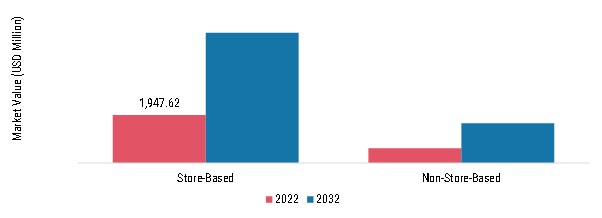
Source: Secondary Research, Primary Research, MRFR Database and Analyst Review
Sourdough Category Insights
The Sourdough Market segmentation, based on category, includes organic and regular. The canned segment accounted for a higher market share in 2021 and is expected to witness the highest CAGR. The regular sourdough generally utilizes conventionally grown grains, including wheat, rye, or oats. The grains undergo cultivation with the aid of synthetic pesticides, herbicides, and fertilizers commonly employed in modern agriculture. The journey of regular sourdough begins with the careful selection of conventionally grown grains, often chosen for their consistency and widespread availability. This choice reflects the pragmatism of conventional farming, which aims to optimize yields and mitigate potential crop losses due to pests and diseases. Regular sourdough, while maintaining the principles of traditional fermentation, may also incorporate commercial yeast to expedite the rising process. This combination of natural fermentation and commercial yeast aligns with the efficiency-driven practices of conventional baking, ensuring a consistent and reliable result. The coexistence of tradition and modern convenience in regular sourdough captures the essence of conventional breadmaking, where practicality often complements the pursuit of flavor and texture. Choosing regular sourdough also acknowledges the economic considerations of conventional agriculture.
Sourdough Regional Insights
By Region, the study segments the market into North America, Europe, Asia Pacific, and the Rest of the World. Europe's Sourdough market accounts for the largest market share 41.70% in 2022 and is expected to exhibit a 9.95% CAGR due to the increasing demand for bakery products. The North America Sourdough Market is experiencing significant growth and transformation, driven by evolving consumer preferences. As a key player in the global Sourdough industry, Europe has witnessed a surge in the production and consumption of various sourdough products. Further, the UK Sourdough market held the largest market share, and as well as UK Sourdough market was the fastest-growing market in the Europe region.
Further, the major countries studied are The U.S., Canada, Mexico, Germany, the UK, Italy, Spain, China, Japan, India, and Australia & New Zealand.
Figure 3: SOURDOUGH MARKET SHARE BY REGION 2022 (%)

Source: Secondary Research, Primary Research, MRFR Database and Analyst Review
The Europe sourdough market has flourished against the backdrop of a rich and diverse culinary heritage, where bread is not just a staple but a cultural emblem. Sourdough, with its ancient roots and distinctive tangy flavor, has made its place in the European market. The market is characterized by a profound appreciation for traditional baking methods, and artisanal bakeries across the continent have played an important role in shaping the sourdough landscape. These bakeries, often rooted in centuries-old techniques, offer an array of sourdough products ranging from rustic loaves to regional specialties, reflecting the varied tastes of European consumers. The European sourdough market is marked by its emphasis on quality ingredients, fermentation expertise, and a commitment to preserving the authenticity of time-honored recipes. The resurgence of interest in artisanal and craft-inspired foods has propelled sourdough into the limelight, with consumers seeking the unique taste, texture, and nutritional benefits associated with naturally fermented bread. This trend is not limited to traditional sourdough strongholds like France and Germany; it spans across the continent, with a resurgence of interest in sourdough in countries like the United Kingdom, and Italy. The Europe Sourdough market comprised Germany, UK, France, Spain, Italy & Rest of Europe, among which the UK emerged as the frontrunner with a market share of 31.75% in 2022.
The North America Sourdough market is expected to grow at a CAGR of 11.04% from 2022 to 2032. The North America sourdough market is studied across the U.S., Canada, and Mexico. The North America sourdough market is expected to grow owing to a growing consumer preference for artisanal and flavorful bread options. Sourdough, with its distinctive tangy taste and textured crust, has emerged as a staple in the region's culinary landscape. This rise is fueled by a broader cultural shift toward traditional and craft-inspired foods, as consumers seek products with authentic flavors and natural fermentation processes. The market is characterized by a diverse range of sourdough products, including classic loaves, specialty rolls, bagels, and even innovative twists like sourdough-based pastries and crackers. The North America sourdough market is witnessing an infusion of creativity, with bakers experimenting with diverse flour blends, seeds, and nuts, and even incorporating ancient grains to craft unique and health-conscious sourdough options. Gluten-free sourdough has also gained traction, catering to the dietary preferences of a broader consumer base. Moreover, the US Sourdough market held the largest market share, and as well as US Sourdough market was the fastest-growing market in the North America region.
The Asia-Pacific Sourdough market is a dynamic and growing sector, The region is studied across China, India, Japan, Australia & New Zealand, and the Rest of Asia-Pacific. Sourdough, with its roots deeply embedded in Western baking traditions, has made significant inroads into the Asian-Pacific market, captivating the palates of consumers who appreciate the nuances of naturally fermented bread. The market is characterized by a blend of traditional craftsmanship and innovative adaptations, reflecting the region's culinary diversity. While rice and rice-based flours have been staples in many Asian countries, the incorporation of sourdough techniques into these traditional grains has resulted in unique and flavorful bread offerings that cater to both local tastes and the global demand for artisanal and specialty products. Artisanal bakeries and boutique cafes are expected to boost the growth of the Asia-Pacific sourdough market, infusing the bread scene with creativity and a commitment to quality. These establishments, often characterized by a fusion of traditional European techniques and local influences, produce a range of sourdough products that go beyond the classic loaf. Sourdough buns, flatbreads, and even desserts featuring sourdough discard are gaining popularity, reflecting the adaptability and versatility of this fermentation method within the region's diverse culinary traditions.
Sourdough Key Market Players & Competitive Insights
The sourdough market is projected to register a CAGR of 10.39% during the review period. The Sourdough Market is characterized by several key dynamics that shape its landscape. Growing adoption of veganism and plant-based diets, the growing trend of home baking & artisan bakeries, an increasing number of health-conscious consumers, and the rising popularity of sourdough are the major growth drivers of the sourdough market across the globe. The increasing consumer preference for natural and artisanal bakery products, fueling the demand for sourdough due to its perceived health benefits and unique flavor profiles. The rising awareness of the importance of gut health further propels the market, as sourdough fermentation is linked to probiotic properties and easier digestibility. Moreover, the trend towards clean-label and organic products has led consumers to seek out sourdough as a natural leavening agent, free from chemical additives. On the supply side, advancements in technology and research have enabled manufacturers to develop specialized sourdough strains, expanding the range of available flavors and applications. The market is also influenced by the surge in home baking, with an increasing number of consumers experimenting with sourdough starters and recipes. This trend has prompted companies to offer convenient and user-friendly sourdough products, such as pre-made mixes and frozen dough. However, challenges exist, including the need for consistent quality and standardization in sourdough production, which can be impacted by variations in raw materials and fermentation conditions. Therefore, the Sourdough Market is driven by consumer preferences for natural, healthy, and diverse bakery products, while innovation, technology, and addressing quality concerns remain crucial for sustained growth in this dynamic industry of consumers seeking novel and health-conscious options in the Sourdough market.
Key Companies in the Sourdough market include
- Puratos (Belgium)
- IREKS GmbH (Germany)
- Lesaffre (France)
- BÖCKER (Germany)
- The Acme Bread Company (USA)
- BOUDIN BAKERY (USA)
- Truckee Sourdough Company (USA)
- Alpha Baking Company, Inc. (USA)
- Mount Sourdough Co. (New Zealand)
- Bread SRSLY (USA)
Sourdough Industry Developments
September 2023: The company (Lesaffre Nordic) has introduced Zavarka under the brand name Livendo which is comprised of scalded sourdough in three different taste profiles.
July 2021: Puratos UK launched British-made living sourdough, in its product portfolio to fulfill the ongoing shifting tastes and preferences regarding bakery products.
Sourdough Market Segmentation:
Sourdough Product Type Outlook
Sourdough Form Outlook
Sourdough Source Outlook
Sourdough Category Outlook
Sourdough Application Outlook
- Bread Products
- Pizza & Pizza Crust
- Cakes & Pies
- Others
Sourdough Distribution Channel Outlook
- Store-Based
- Non-Store-Based
Sourdough Regional Outlook
- North America
- Europe
- Germany
- France
- Italy
- Spain
- UK
- Rest of Europe
- Asia-Pacific
- China
- Japan
- India
- Australia & New Zealand
- Rest of Asia-Pacific
- Rest of the World
- Middle East
- Africa
- South America
|
Report Attribute/Metric
|
Details
|
|
Market Size 2022
|
USD 2,553.57 million
|
|
Market Size 2032
|
USD 6,900.13 million
|
|
Compound Annual Growth Rate (CAGR)
|
10.39% (2023-2032)
|
|
Base Year
|
2023
|
|
Forecast Period
|
2023-2032
|
|
Historical Data
|
2019 & 2021
|
|
Forecast Units
|
Value (USD Million)
|
|
Report Coverage
|
Revenue Forecast, Competitive Landscape, Growth Factors, and Trends
|
|
Segments Covered
|
Product Type, Form, Source, Category, Application, Distribution Channel, and Region
|
|
Geographies Covered
|
North America, Europe, Asia Pacific, and the Rest of the World
|
|
Countries Covered
|
The U.S, Canada, Mexico, Germany, France, UK, Italy, Spain, China, Japan, India, Australia & New Zealand
|
|
Key Companies Profiled
|
Puratos (Belgium), IREKS GmbH (Germany), Lesaffre (France), BÖCKER (Germany), The Acme Bread Company (USA), BOUDIN BAKERY (USA), Truckee Sourdough Company (USA), Alpha Baking Company, Inc. (USA), Mount Sourdough Co. (New Zealand), and Bread SRSLY (USA), and among others.
|
|
Key Market Opportunities
|
· Shifting Consumer Preference Toward Sustainable Food Products
· Growth Of E-Commerce and Online Shopping
|
|
Key Market Dynamics
|
· Growing Adoption of Veganism and Plant-Based Diets
· Rising Trend of Home Baking & Artisan Bakeries
· Increasing Number of Health-Conscious Consumers and Rising Popularity Of Sourdough
|
Sourdough Market Highlights:
Frequently Asked Questions (FAQ) :
The Sourdough market accounted for USD 2,553.57 million.
Increasing adoption of veganism and plant-based diets coupled with the rising trend of home baking & artisan bakeries are the key driving factors for the Sourdough market
The growth rate of the Sourdough market is 10.39% CAGR.
Europe region held the largest market share in the Sourdough market.
Puratos (Belgium), IREKS GmbH (Germany), Lesaffre (France), BÖCKER (Germany), The Acme Bread Company (USA), BOUDIN BAKERY (USA), Truckee Sourdough Company (USA), Alpha Baking Company, Inc. (USA), Mount Sourdough Co. (New Zealand), and Bread SRSLY (USA), among others are the key players in the Sourdough market.
Technology plays a crucial role in scaling artisanal sourdough production, ensuring consistency, and quality, and meeting increased consumer demand efficiently.










